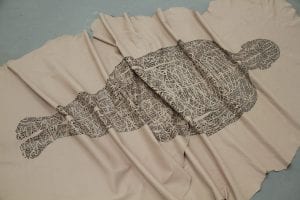
The Science and Culture of Insomnia
This fourth post in the Adolescent Lives series showcases the wonderful initiatives exploring sleep and sleeplessness, led by Clinical Scientist Kimberley Whitehead, from the UCL Department of Neuroscience, Physiology and Pharmacology, and Professor Matthew Beaumont from the Department of English Literature.

Andrew Carnie Sleep Project 2017
Most people have experienced insomnia at some point in their life, to varying degrees. About 10% of adults are affected by chronic insomnia – decreasing their quality of life and mental wellbeing. Though a clinical diagnosis can help to identify and mitigate the causes of sleeplessness, it doesn’t necessarily paint the full picture of patients’ experience of insomnia.
“I was working in the field of sleep neurology and I always felt that biology by itself was not fully capturing the experience of my patients and how they reacted to sleep disorders”, Kimberley shares. Physiological indicators can give some insight into the quality of sleep, but leave out a large aspect of the patients’ experience and how they relate to it. In reality, the sleep experience is not restricted to the time we spend in bed, but is influenced by a large variety of factors – life events, moods and emotions, and even the individual’s perception and understanding of insomnia itself.
How are sleep patterns affected by our environment and physical condition? How was insomnia perceived throughout history and treated in the arts? How do our objective quality of sleep and subjective experience differ? These are the topics that Kimberley and Matthew explored in a series of events involving scientists, artists, and members of the public.
In a symposium on sleep and sleeplessness, Kimberley and Matthew brought together perspectives from clinicians, biologists, historians, artists, and cultural critics:
- Professor Matthew Beaumont (University College London, Department of English Language and Literature / UCL Urban Laboratory)
- Kimberley Whitehead (University College London, Department of Neuroscience, Physiology and Pharmacology)
- Andrew Carnie (artist)
- Dr Sofia Eriksson (National Hospital for Neurology and Neurosurgery)
- Professor Simon Morgan Wortham (Kingston University, Department of Humanities)
- Professor Nick Franks (Imperial College London, Department of Life Sciences)
- Dr Sasha Handley (University of Manchester, Department of History)
- Dr Fran Knight (University College London, Institute of Education)
- Dr Stefan Blayney (University of Sheffield, Department of History)
Attendees had a chance to share their thoughts at a drinks reception, to the sound of a sleep-inspired music set specifically created by Alex Solo. This particular aspect of this public engagement initiative was supported by the Physiological Society.
The multi-disciplinary perspectives from the symposium fed into an essay published by Kimberley and Matthew in the Lancet, in which they approach sleeplessness from two complementary perspectives – the sciences and the humanities – and explore how the two viewpoints intersect and shed new light.
Following on the symposium, Kimberley organised an exhibition, ‘Representing the body: art, physiology and pathology collide’, at the UCL Pathology Museum in collaboration with curator Subhadra Das and artist Andrew Carnie.

Andrew Carnie, Jump. Laser cut lambs leather, 2017.
The commissioned series of artwork explored the transition from wakefulness to sleep, with the artist particularly inspired by the concept of the body being ‘swallowed’ by sleep, and the motif of dusk. This exhibition was celebrated with an opening event in which Kimberley, Andrew, and pathologist Alan Bates from the Royal Free Hospital discussed their work.
In parallel, as part of the Grand Challenges’ Adolescent Lives series, Kimberley and Matthew wanted to explore how adolescents can influence and direct the development of sleep research to facilitate co-production of knowledge. Kimberley conducted a workshop involving young patients with cancer at the Teenage Cancer Unit, facilitated by artist Frances Newman, which highlighted the influence of all aspects of life on people’s sleep habits and experience. Topics frequently raised by the participants were the pleasure they took in sleeping, fluctuations in sleep according to what they knew was planned for the following day, and domestic pre-sleep routines such as spending time with pets. These contributions will inform Kimberley’s research going forward.

Andrew Carnie, Wave, goodbye.
Water colour and stitch on Hahnemühle Leonardo paper, 2017.
“All the work that has come out of this collaboration, including the article we published in the Lancet, has been about trying to find a common language for scientific, social, historical approaches”, Matthew concludes. “It has reinforced our initial speculation that this was a really interesting way of drilling down into both the hard sciences and the broader social questions. I am delighted that Kim has reached out to me.”
Further resources:
- Grand Challenges 2018 Showcase – The science and culture of sleep and sleeplessness
- Grand Challenges Adolescent Lives Showcase – Researching the Intersection between the Neurobiology and Sociology of Sleep and Sleeplessness in Adolescents
- UCL Lunch Hour Lecture – Understanding sleep and sleeplessness: can science and cultural history be used together?
- Whitehead & Beaumont, Insomnia: a cultural history, The Lancet (2018)
- Whitehead, Sleep across the animal kingdom, The Physiological Society blog
- Beaumont, Nightwalking and Insomnia in the City, UCL European Institute


Comments are closed, but trackbacks and pingbacks are open.